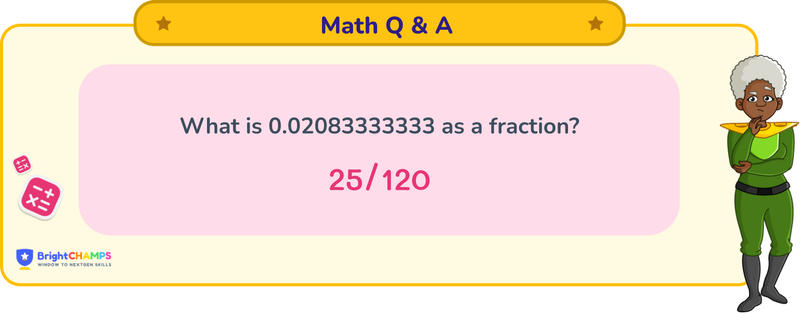Summarize this article:
 206 Learners
206 LearnersLast updated on 5 August 2025
0.02083333333 as a Fraction

Numbers can be categorized into different types. Fraction is one of its kind. It is always represented in the form of p/q, where p is the numerator and q is the denominator. Fraction represents a whole and a fractional part. Decimals represent the fractional part of numbers. For example, 1/2, the numbers in decimal are expressed with a decimal point (.), For example, 0.02083333333, we are going to learn how to convert a decimal to a fraction.

What is 0.02083333333 as a Fraction?

Answer
The answer for 0.02083333333 as a fraction will be 1/48.
Explanation
Converting a decimal to a fraction is a task for students that can be done easily. You can follow the steps mentioned below to find the answer.
Step 1: Firstly, any decimal number should be converted to fraction for easy calculation. Here, 0.02083333333 is the number on the numerator and the base number 1 will be the denominator. Then, 0.02083333333 becomes 0.02083333333/1.
Step 2: To remove the repeating decimal from the fraction, recognize that 0.02083333333 is a repeating decimal where 0.0208 is the non-repeating part and 33333 is the repeating part. Therefore, you can express it as 0.0208 + 0.000033333...
Step 3: Convert each part to a fraction. The non-repeating part 0.0208 can be written as 208/10000. The repeating part 0.000033333... can be expressed as 1/30000. Combining these, the fraction becomes (208/10000) + (1/30000).
Step 4: Find a common denominator to add the fractions: 208/10000 + 1/30000 = (624/30000) + (1/30000) = 625/30000.
Step 5: Simplify the fraction by finding the GCD of 625 and 30000, which is 625. 625/30000 = 1/48.
Thus, 0.02083333333 can be written as a fraction 1/48.

Important Glossaries for 0.02083333333 as a Fraction
- Fraction: A numerical quantity that is not a whole number, representing a part of a whole.
- Decimal: A number that uses the base ten and includes a decimal point to separate the whole part from the fractional part.
- Repeating Decimal: A decimal fraction in which a figure or group of figures is repeated indefinitely.
- Numerator: The top part of a fraction, indicating how many parts of the whole are being considered.
- Denominator: The bottom part of a fraction, showing how many parts make up a whole.

Explore More math-questions
![Important Math Links Icon]() Previous to 0.02083333333 as a Fraction
Previous to 0.02083333333 as a Fraction
![Important Math Links Icon]() Next to 0.02083333333 as a Fraction
Next to 0.02083333333 as a Fraction





